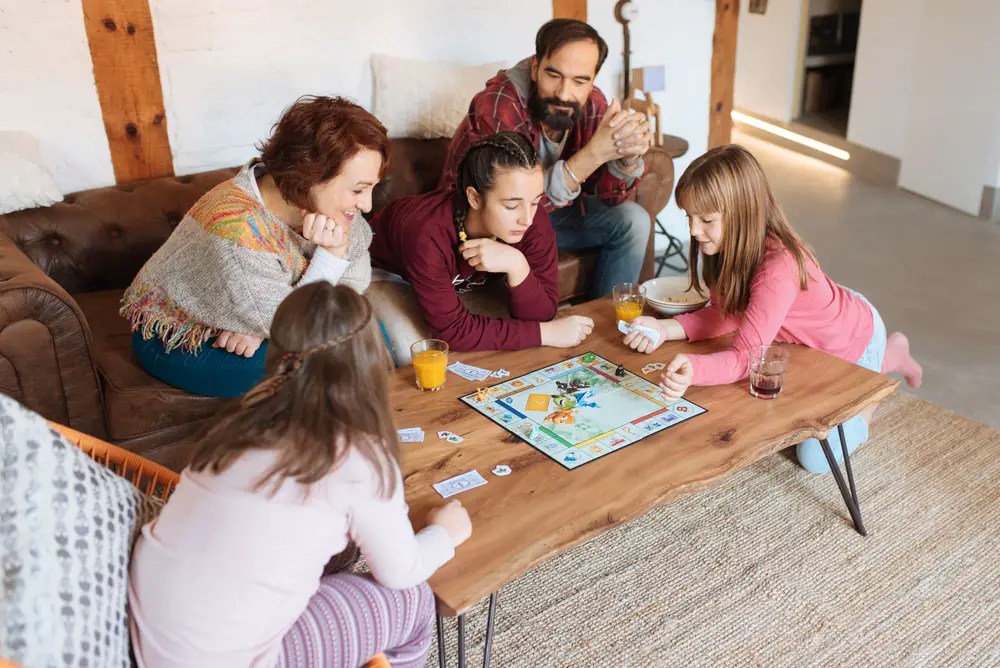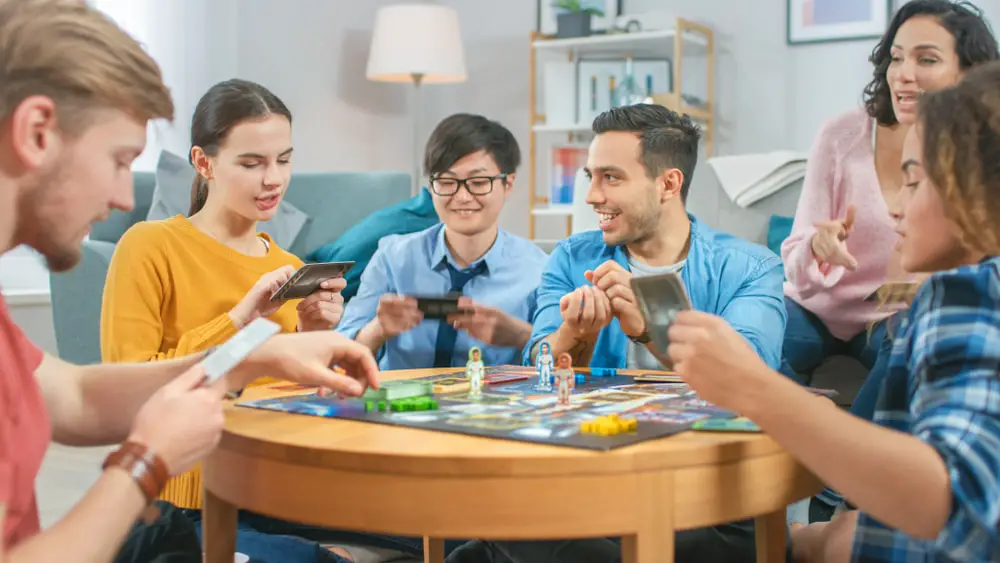Teaching board games can be really, really hard at the best of times. Knowing this, I decided to create a list of strategies I’ve used over the years to help the people I play games with learn and enjoy the games more. Now, what are those things?
When it comes to teaching board games, I find the following strategies useful: memorize the rules, trust yourself, anticipate questions, keep the teaching short, practice teaching, teach the rules in a specific order, accept that sometimes games go bad, use visuals, do a practice round, prepare setup before playing, be prepared to lose, run the game, be lenient, never introduce expansions at first, know your audience, rely on others, and don’t do all of this at once.
Table of Contents
- Master List For Teaching Board Games
- 1. Memorize The Rules
- 2. Trust Yourself With The Rules
- 3. Anticipate And Embrace Questions
- 4. Keep The Teaching Short
- 5. Practice Teaching The Rules
- 6. Teach The Rules In A Specific Order
- 7. Accept That Sometimes Games Go Bad
- 8. Use Visuals, Including Reference Sheets
- 9. Do A Practice Round
- 10. Prepare Setup Before Playing
- 11. Be Prepared To Lose
- 12. You’ll Have To Run The Game Too
- 13. Be Lenient On The Other Players
- 14. Never Introduce An Expansion At First
- 15. Know Your Audience
- 16. It’s Okay To Rely On Others
- 17. Do Not Try To Do This All At Once
- Did You Know?
- Conclusion: Master List For Teaching Board Games
Master List For Teaching Board Games

Everyone has their own way of teaching board games. I know that, and I’m okay with that. In fact, I think that’s awesome.
The reason I’m saying all this is that I want people to remember that my way of teaching games is just one way. Sure, it’s backed by more than 10 years of playing and teaching board games, but my way isn’t the only way or even the best way.
In the end, my way is just a way, and it’s a way that will continue to evolve as I do. But, for right now, this is how I teach board games, and I’ve found these strategies to be successful when doing so.
So, without any further ado, here is my master list for teaching board games.
1. Memorize The Rules
This should go without saying, but you’ll want to know the game’s rules like the back of your hand. Ideally, you’ll want to know them so well that you won’t have to look in the rulebook at all while playing the game. You probably still will, but that’s okay!
Memorizing the rules isn’t about getting them perfect; it’s about knowing them well enough for everyone to feel like they know what they’re doing and have a good time. That includes you too, so don’t stress yourself out trying to memorize the rules perfectly.
2. Trust Yourself With The Rules
You will make mistakes with the rules. That’s going to happen and it’s okay. I’ve made so many mistakes my friends make fun of me for a trusty catchphrase of mine that makes an appearance at least once a game session, that being, “Oh yeah, I forgot to mention…” Mistakes don’t ruin games otherwise no one would play them.
The bottom line is to trust yourself. You know what you’ve read, learned, and practiced. You don’t have to keep going back into the rulebook to check everything unless you just don’t remember.
And there will be rules you will forget. This is also okay! When you realize you’ve forgotten a rule, ask yourself if it’s had an effect on the game so far? Maybe it has, but if everyone’s having fun, then you don’t need to bring it up; you can do that in the next game.
If you do need to bring a rule up mid-game though (I would only recommend this if it’s super important or if you realize you forgot it pretty quickly), just own it. It happens, the other players will tease you a bit, and you’ll all move on and keep having fun together.
3. Anticipate And Embrace Questions
Your players are going to ask questions. Sometimes they’re really simple and sometimes they’re really complex. Sometimes you’ve considered those questions beforehand and sometimes not.
Whatever the situation, anticipate that there will be questions. Questions are not a bad thing though. In fact, they’re the opposite.
If your players are asking questions it means they’re invested in your teaching and the game they’re about to play. Whether they need something re-explained or clarified, it doesn’t matter. Players asking questions is a good thing, and it gives you even more time to shine as a teacher and a board gamer.
4. Keep The Teaching Short
I once lived by the rule that simple games shouldn’t take more than 5 minutes to explain, intermediate games shouldn’t take more than 10, and complex games no more than 15. I don’t live by this rule anymore, but I do keep in mind that no matter how complex the game, there’s only so long I can hold my players’ interest, and there’s only so much information they can take in.
So, what do you do when you have tons of rules in the rulebook? Well, you don’t have to teach all of them at the start. Some games will have what I call, “little rules.” Little rules are rules for specific situations that occur in a game.
As an example, in the game, Talisman, there are rules about what to do if your character gets turned into a toad. Does anyone need to know that at the start of the game? Not at all. They’ll only need to know that once it actually happens because those rules won’t matter until that happens if it happens.
So, consider what rules you can leave out in the initial explanation and how you can explain the rules the players do need to know right away to keep them clear and short.
5. Practice Teaching The Rules
There may be nothing more important than this. Practice, practice, practice. Don’t go overboard, but do a practice run once or twice. See how it sounds when you explain the rules out loud and consider how people might receive that information.
If you discover it doesn’t sound great or comes across as confusing, make adjustments and practice again. All it really takes is one or two practices though. You should be good after that.
6. Teach The Rules In A Specific Order
I like to teach the rules in the following way: theme, how to win/how the game ends, game structure, turn structure, then maybe a little rule or two if they’re really that important.
Theme
The theme is as simple as a quick explanation of what the game is supposed to make you feel like you all are doing. Are you factory workers building cars? Are you fantasy warriors fighting a great evil?
Explain the theme in 1-2 quick sentences and then be done with it. If the players want to know more, they’ll ask. Besides, a good theme will come through on its own.
As an example, the theme of Terror Below is that you’re trying to collect and deliver worm eggs while fighting monstrous underground worms. It takes place in the desert, the game is a little silly on purpose, and it’s heavily inspired by the Tremors franchise.
How To Win/How The Game Ends
Next, explain how to win and how the game ends. This is starting with the end in mind and it helps to focus everyone’s thinking. The game structure, the turn structure, all of it comes from how players win the game or how the game ends.
Game structure
Then, explain the game structure. Is it three rounds? Do players go one at a time or all at once?
Turn structure
Next, explain the turn structure. What is a player doing on their turn and in what order?
Little rules
Lastly, explain any little rules if you need to. You usually won’t, but sometimes explaining one or two is necessary.
During and after you’re done explaining, take small breaks to ask questions. This also helps chunk the teaching so that your players can get a quick break to better absorb the information you’ve just told them.
7. Accept That Sometimes Games Go Bad
Things happen. People get distracted or get a call they need to take. Maybe the game just wasn’t the right choice for that night.
Whatever the reason, there are plenty of reasons that make games go bad that have nothing to do with teaching. And if the reason a game goes bad is because of your teaching, instead of taking it personally, learn from the experience and see what you can do differently to make it better next time.
If you trust the people you’re playing with, perhaps even ask them for help with this. Let them know you want it to go better and see what they have to say.
8. Use Visuals, Including Reference Sheets
Some games will come with these already, but if not, and if you have an especially complex game to teach, something visual for the players to focus on goes a long, long way. Visuals in general are helpful, but reference sheets explaining a turn or icons in the game help to create a much smoother game experience.
9. Do A Practice Round
If you can, do a quick practice round. Some games will walk you through this on their own, but this is rare. Instead, set up the game for real, then play one round as a practice. This can mean a few things.
Firstly, you can play with as much information showing as possible. Cards would be faceup and so would tokens, for example. That way players can see what’s happening, and you can help them by helping them to make decisions based on what they have.
Secondly, you can play a round for real as if you were really playing the game, but play the round a bit slower. Sometimes, games are simple enough that players get it this fast, and you can use this round to answer any questions they might have before seeing if they want to keep going or start over.
I also recommend going first if you can. You can offer the ability to go first to the other players, but it’s usually better for them to see what you do before they go. Of course, you may not have a choice if the game determines a first player for you, but you can always bend the rules a bit if needed.
10. Prepare Setup Before Playing
This rule is an interesting one, but here’s why I do it: time. I’d rather spend more time playing a game or two or four during the game night rather than setting them up. Sometimes, setup can take a really long time!
So, instead of wasting precious time during game night setting the game up, I set up as much as I can beforehand. I shuffle the decks that need to be shuffled, organize the pieces, and so on. The more you can take care of before game night, the more time you can spend having fun on game night.
11. Be Prepared To Lose

I’m a pretty good game player. Heck, I went to Gen Con twice and won a preliminary round of King of Tokyo both years I went. I’ve won my fair share of games besides that (and have lost a bunch too, haha), but when I teach I do so with the expectation of losing.
Why though? Well, because my main focus is on teaching the game. The next time we play I can focus more on just playing, but I want that first experience to be stellar, so I focus on teaching and making sure everyone is having a good time doing so.
What that means is that I’ll be answering questions throughout the game, running the game, and not being able to focus as much on playing the game. That means I’m more likely to lose, and I’m absolutely okay with that.
12. You’ll Have To Run The Game Too
This will come into play a bit more in the number 16 tip, but even though you can get help from the other players to run the game, to help maximize their fun and to keep the game experience as smooth as possible, I run the game as much as I can. This means taking care of moving tokens around, drawing cards from decks, making change for money, and so on.
Now, this doesn’t mean I move other players’ pieces or things, but it can sometimes mean that too (typically only if it’s too hard for them to reach it). But it does mean I’m taking care of as much as possible so everyone can have a good time. It helps that I have a great time doing this too.
13. Be Lenient On The Other Players
Your players are going to make mistakes. It’s okay! They might get confused or forget something, so what do you do?
What I do is I say, “Hey, if you want to take it back, no big deal.” From there, they get to make the choice. It’s no big deal at all because it’s just a game and they’re playing it for the very first time in their lives.
Sometimes, I’ll even offer help with strategies, although I stay away from this as much as possible because that starts to get into the realm of alpha gaming. Still, sometimes it can help a person to feel confident in their decision and to keep on having a good time gaming.
14. Never Introduce An Expansion At First
We all know that part of the fun of board gaming is that the experiences keep on giving. Sometimes that’s because the base game is replayable, but sometimes it’s because it has expansions. And oh how we so desperately want to introduce those expansions!
But we can’t. At least not yet. We have to wait until the other players have gotten some experience with the game first, then we can introduce them to subsequent plays.
Sometimes it pays to wait, and holding off on introducing expansions until it’s a good time to do so is certainly no exception to this.
15. Know Your Audience

Are you playing with gamers? Friends who don’t play board games often? Family members, who are younger?
Whoever you’re playing with, how you teach will and should change depending on who’s at the table with you. For example, say you were playing with someone in their 60’s, your girlfriend, brother, and a friend.
How do you teach that game? What language do you use? Personally, when I was in this situation, I chose a simple party game (Werewords, which is awesome, by the way) and explained it as simply as I could.
Why? Because I had such a varied audience that it would be difficult to do otherwise. The person in their 60s was my dad, and he did have some gaming experience, but not a ton. My brother was the same, but he had played a lot of video games, and so on and so on.
So, it was easier just to keep everything at a level that we all knew and understood. And, it worked! We had a great time.
The bottom line is when you’re teaching think about who you’re teaching the game to. What experiences do they bring to the table, how short or long are their attention spans, what are their interests, etc? It really does help.
16. It’s Okay To Rely On Others
Okay, so at this point, you might be saying, “This is a lot!” It is a lot, that’s why number 17 exists below, but that’s also why once you get comfortable with teaching, you start to rely on others. What do I mean by that?
Well, relying on others doesn’t mean you rely on them to teach the game, although you can do that too if another person has played or taught it before. But you can also rely on players to help you do setup, to help run the game if they’re comfortable doing so, and so on.
And sometimes, sometimes you’ve done such a great job that you can sit back and just play the game too, just like a fresh player would because all the other players and the game are taking care of themselves. This is a great experience that doesn’t happen all that often, but it’s really, really cool when it does.
aweSo, enjoy it!
17. Do Not Try To Do This All At Once
It’d be great if we got things perfect; it really would. But we don’t and that’s part of being human beings.
With that said, realize that not even the best teachers can do all of these things all the time. It’s hard to remember all these steps and even harder to do them all well on a game night. So, rather than do that, pick one or two you want to focus on, practice them until you’ve mastered them through teaching a few games, then add a couple more.
Also, you may not even end up needing to use all of these anyway! Sometimes game groups don’t need them.
Did You Know?
(Each time you refresh the page you will get a new “Did You Know” fact!)
Did you know there’s a great filler game about sailors trying not to get eaten by a sea monster? If you’re interested, check out my review of Uk’otoa in this article!
Conclusion: Master List For Teaching Board Games
So, there you have it, my take on teaching board games. I do truly hope you find something useful here that can make your board game experiences even more enjoyable than before.
That said, I’d love to hear what those things are. What game do you plan to try these tips out on first and why?
Let us know in the comments below!
And remember, keep on gaming, you maniacs.

